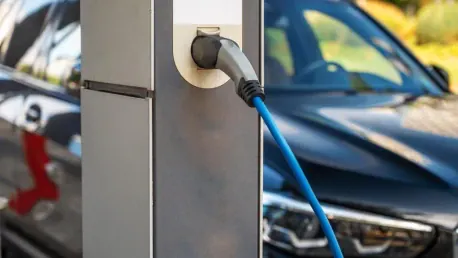The transition to electric vehicles (EVs) for UK businesses is gaining momentum, but inadequate on-street charging infrastructure poses a significant hurdle. Vauxhall’s recent research, encapsulated in the “Electric Van Adoption Report,” sheds light on this challenge, exploring the dependence on public EV charging and the necessity for improvements to support fleet electrification.
Growing Interest in Electric Vans
Increasing Demand Among Businesses
The study highlights a robust interest in electric vans among UK businesses. A significant percentage of fleet operators reveal their intent to include EVs in their fleets, demonstrating a clear shift towards greener transportation solutions. The push for sustainability and reduced carbon footprints has driven businesses across various industries to consider electric vehicles as integral components of their fleet. This growing inclination signifies not only a recognition of the environmental benefits but also an acknowledgment of the potential cost savings associated with electric vans over their petrol and diesel counterparts.
Despite the enthusiasm, the transition remains fraught with challenges. Many businesses find themselves grappling with the logistics of integrating electric vans into their daily operations. The conventional infrastructure and operational frameworks that support petrol and diesel vehicles need significant adjustments to accommodate the unique requirements of EVs. This calls for a concerted effort from both the public and private sectors to facilitate smoother transitions and ensure that businesses can harness the full potential of electric transportation.
Dependency on On-Street Charging
A striking 91% of surveyed businesses rely on on-street public charging for their electric vehicles. However, over 23% cite the lack of sufficient on-street charging options as the primary barrier to adopting EVs, underscoring the urgent need for infrastructural development. Many businesses that do not have the luxury of private charging stations are heavily dependent on the availability and accessibility of public chargers, which are often clustered in urban areas, neglecting the needs of suburban and rural regions.
The inconvenience of insufficient on-street charging points means that fleet operators have to deal with longer dwell times and potentially disruptive detours for charging purposes. This reality not only hampers operational efficiency but also raises concerns about the feasibility of maintaining a consistent and reliable service. Moreover, the uneven distribution of charging infrastructure highlights the necessity for strategic planning and investment to ensure that on-street charging facilities are evenly spread, providing businesses across the UK equal opportunities to participate in the green transition.
Current Challenges in EV Adoption
Inadequate Charging Infrastructure
Businesses face substantial challenges in installing EV charging provisions at their operating bases. The report indicates that 81% of respondents find this problematic, making the transition to a fully electric fleet complex and demanding. The installation of EV chargers at business premises often involves navigating regulatory hurdles, securing financial investments, and addressing structural constraints. For many businesses, especially small to medium-sized enterprises (SMEs), these challenges can present obstacles that delay or prevent the shift towards electric vehicles.
Moreover, the existing public charging infrastructure does not yet offer the comprehensive coverage required to support the growing number of EVs on the roads. This gap exacerbates the reliance on an insufficient number of chargers, leading to longer queues, increased waiting times, and ultimately, a dampened enthusiasm for electrification. To address these issues, coordinated efforts between local authorities, private enterprises, and government bodies are essential. These partnerships could facilitate the creation of dedicated EV zones, optimize the placement of chargers, and streamline the requisite approvals and installation processes.
Long-Term Electrification Goals
While businesses aim to transition to an all-electric fleet by 2035, aligned with government targets, they foresee challenges. They estimate the feasibility of complete adoption no earlier than 2028, reflecting the infrastructural hurdles in their path. The ambition to meet governmental deadlines is reflective of broader compliance with climate policies and an effort to contribute to national sustainability goals. However, the reality of achieving these targets necessitates addressing current limitations swiftly and effectively.
Many businesses are preparing for a phased approach, gradually replacing their fleets as the infrastructure and technology become more robust and accessible. This staged transition, while practical, requires support in the form of incentives, grants, and advisory services to assist companies in making informed decisions about their investments in EVs. The development of supportive policies and the allocation of resources towards addressing the primary bottlenecks in EV adoption will be crucial in closing the gap between ambition and reality.
Industry-Specific Insights
Concerns in Manufacturing and Utilities
The manufacturing and utilities sectors exhibit notable apprehension regarding the transition. Around 90% of fleet operators express that moving entirely to electric vans is significantly challenging, highlighting industry-specific concerns. These sectors often rely on a high volume of larger commercial vehicles that require longer ranges and more powerful performance capabilities. The current market offerings in electric vans may not yet fully meet these requirements, creating a barrier to complete electrification.
Additionally, operational aspects such as load-carrying capacity, range under full load conditions, and the availability of charging infrastructure capable of supporting high-mileage demands are key factors influencing these sectors’ hesitancy. Addressing these industry-specific needs requires specialized solutions, including advancements in battery technology, increased vehicle ranges, and the development of a more robust charging network tailored to heavy-duty applications. Collaboration between manufacturers, technology developers, and industry stakeholders is vital to innovate and produce tailored EV solutions that meet the unique demands of these sectors.
Positive Business Impacts
Despite challenges, the report showcases the benefits of EVs. About 83% of fleet operators using electric vans report positive business impacts, and 91% believe that an all-electric fleet enhances customer perception, pointing to potential long-term advantages. These benefits encompass reduced operational costs, lower maintenance requirements, and contributions to corporate social responsibility initiatives. The lower cost of electricity compared to diesel and petrol fuels implies substantive savings over the vehicle’s lifespan, making the financial investment in EVs more attractive.
Furthermore, electric vans offer the advantage of quieter operation and zero tailpipe emissions, leading to positive implications for urban environments and public health. These attributes not only bolster the businesses’ green credentials but also improve their standing among increasingly environmentally-conscious customers. As consumers become more attuned to corporate sustainability practices, businesses showcasing a commitment to reducing their carbon footprint can potentially capture a larger market share, attract eco-minded clients, and foster brand loyalty.
Progress and Government Support
Uptake and Charger Deployment
There’s been a notable increase in electric van uptake, with a 1.3% growth in 2024 over 2023. Additionally, the number of public charge points has increased significantly, boosted by the Government’s Local EV Infrastructure (LEVI) Fund. These developments reflect positive steps towards accommodating the rising demand for electric vehicles and providing the necessary support for continued growth. The government’s active role in financing and endorsing the expansion of EV infrastructure represents a critical component in achieving the targets set for nationwide electrification.
The LEVI Fund, designed to address the infrastructure deficiencies, has enabled the deployment of new chargers at a commendable rate, serving to alleviate some of the immediate pressures faced by fleet operators. However, while the increasing numbers of public charge points are encouraging, the real measure of success lies in their strategic deployment. Ensuring that these resources are distributed efficiently to prevent congestion and serve both urban and rural regions remains an ongoing challenge that requires continuous attention and adjustment.
Distribution Imbalance
An uneven distribution of on-street chargers persists, with 72% located in Greater London. This imbalance stresses the need for a more strategic approach to ensure widespread access to EV power sources across the country. This concentrated availability in metropolitan regions exacerbates the disparity experienced by businesses operating outside these areas. Such uneven distribution is largely driven by the higher demand for EV infrastructure within densely populated areas, yet it inadvertently creates barriers for the wider acceptance and use of EVs in less urbanized regions.
Rural and suburban businesses often face longer distances between charging points, making route planning and efficient energy management more complex. Addressing this imbalance necessitates comprehensive infrastructural planning and investment that prioritizes equal access. Initiatives like expanding the LEVI Fund’s focus to explicitly include underserved areas can significantly propel efforts to achieve a balanced national EV infrastructure. Moreover, involving local authorities in tailoring strategies that address specific regional needs can facilitate a more inclusive transition to electric vehicles.
Vauxhall’s Role in Electrification
Support for SMEs
Vauxhall supports SME electrification by offering free wallbox installations for new electric van purchases. New model introductions with reduced prices and extended ranges aim to make electric vans more accessible for businesses. This effort underscores Vauxhall’s commitment to lowering barriers and facilitating a smoother shift toward electric mobility for smaller enterprises, which often face higher hurdles in adapting to new technologies compared to larger corporations.
By lowering the initial costs associated with EV infrastructure and providing models that cater to the operational needs of SMEs, Vauxhall helps alleviate some of the financial and logistical pressures. Furthermore, the introduction of more competitively priced models with enhanced range capabilities signifies ongoing innovation aimed at meeting the diverse needs of business fleets. Such steps not only augment the appeal of electric vans but also help expedite their adoption, driving market growth and reinforcing Vauxhall’s position as a pivotal player in the electrification process.
Electric Streets of Britain Campaign
The shift to electric vehicles (EVs) for businesses in the UK is picking up speed, yet the lack of sufficient on-street charging infrastructure remains a major obstacle. Vauxhall’s recent study, outlined in the “Electric Van Adoption Report,” highlights this pressing issue. The report delves into how reliant businesses are on public EV charging and emphasizes the urgent need for enhancements in this area to support the transition to EV fleets. According to Vauxhall’s findings, fleet managers are often hampered by the scarcity of accessible, reliable charging points, making it challenging to meet their electrification goals. Moreover, the inconvenience of inadequate charging facilities could potentially slow down the adoption rate of electric fleets, impacting environmental and economic benefits. Therefore, for a smoother transition to electric mobility, it’s essential for businesses and policymakers to focus on improving the public charging infrastructure. This would not only simplify the switch to EVs but also ensure sustainable growth and broader acceptance of electric vehicles in commercial transportation.









